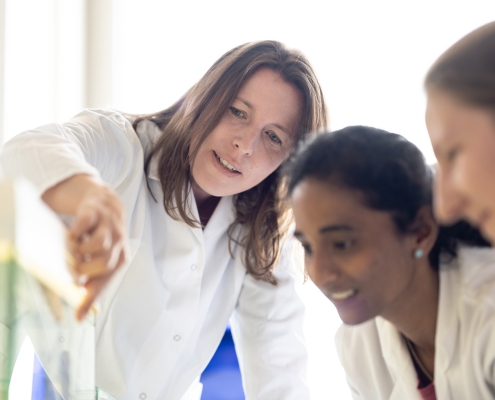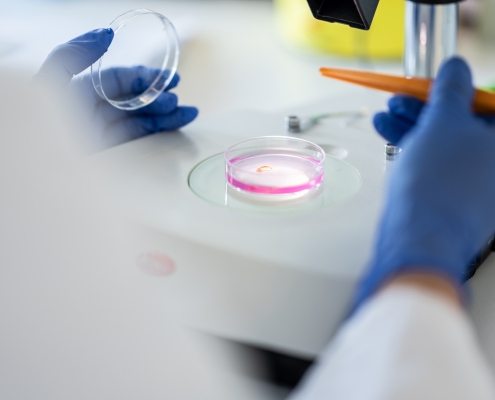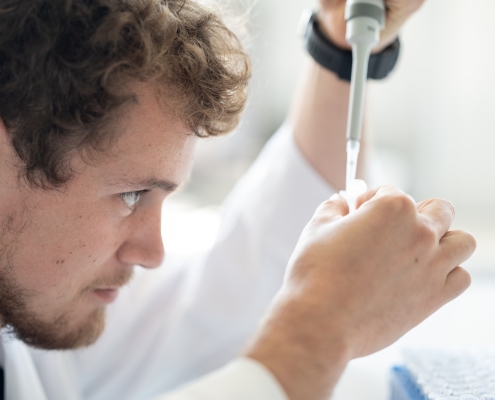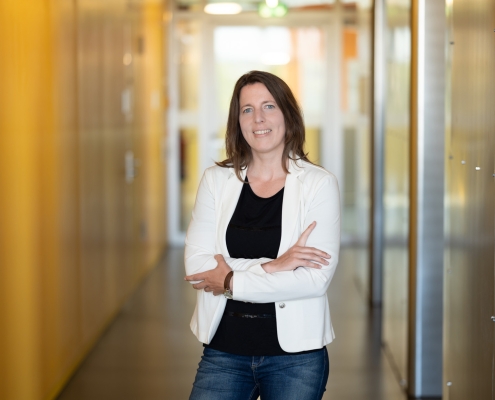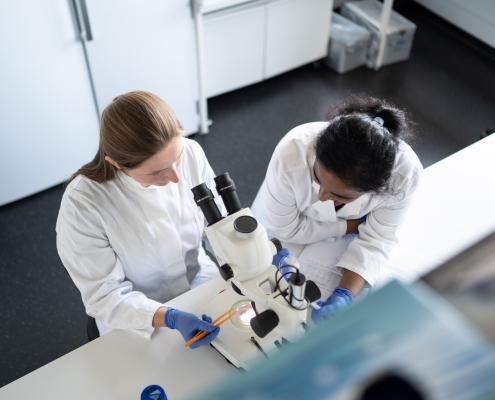
Passion for unknown ways
03.11.2022 / Text: Alexandra von Knobloch / Fotos: Sascha Mannel
Passion for unknown paths
Dr. Simone Häberlein, who has just completed her professorial qualification, heads a junior research group that studies tropical worm parasites. Her work makes use of the latest methods—and a classic research spirit.
Being creative: This is how Simone Häberlein describes what fascinates her most about her job. If you think she is a painter, designer or book author, you’re wrong. The 40-year-old woman from Bavaria is a biologist (PD Dr. rer. nat.), has a professorial qualification in zoology and molecular biology, and conducts basic research. Parasitic worms are her field of expertise. Her career as a scientist revolves around finding out more about how these parasites manipulate their host organism and how—conversely—the host affects the creature that has infested it.
Häberlein and her colleagues are investigating this interaction at the molecular level, i.e. in an area invisible to the naked eye and where only some microscopes can still penetrate. Anyone working in this field needs a high level of abstraction and analytical thinking.
But this is not the terminology that comes to her mind when she talks about what she does. She emphasizes creativity. “As a scientist, I have the freedom to look for unresolved questions and think of ways to answer them,” she says.
Dream job: scientist
She and her team are investigating a specific class of enzymes, the protein kinases, and want to clarify which of these kinases are produced – and where in the parasite’s body – under certain environmental conditions. In biology, such methods are called omics analyses. They allow very complex processes in cells to be visualized, and it has only been in the last few years that even two-dimensional analyses, i.e. in a spatial context, have become technically possible. “As far as I know, we are the first working group in the world to apply this on liver flukes,” Häberlein reports. She is expecting “groundbreaking results for the next ten years.”
The long-term goal behind Häberlein’s LOEWE project is ambitious: DRUID, funded by the German state of Hesse, seeks to help develop new therapies for neglected tropical diseases that primarily afflict the poorer populations of emerging and developing countries. Fasciolosis, an infection with liver flukes, is on the list of diseases for which the World Health Organization (WHO) sees a particularly urgent need for action.
Inspiration from cancer research
Häberlein’s DRUID project is called ‘The Fasciola kinome as a source for new drug targets’. Her initial hypothesis: If a protein kinase could be found that is essential for the liver fluke to survive, this would be a possible starting point for developing a drug that kills liver flukes. How did she come up with it? Cancer therapy provided the inspiration. Drugs against protein kinases, or kinase inhibitors, have been used for quite a while to destroy cancer cells. The creative transfer of this concept to the worm parasite Schistosoma has already proved successful by colleagues in Giessen. With transfer of this concept to fasciolosis, the idea of a promising new methodology, and a successful project proposal for a DRUID junior research group, the work is running at full steam now.
DRUID supports Häberlein’s junior research group with a PhD student position and a part-time position for technical assistants. In total, this molecular biologist heads five doctoral students, a medical technician, and a chemistry lab technician in her interdisciplinary, international team. In addition to biologists, the team includes a veterinarian and a biophysicist. “This support is particularly valuable for me,” says Häberlein. The more experts are involved in a scientific study, the faster it progresses.
Only a few experts worldwide
Häberlein herself is one of the world’s experts in liver fluke molecular biology and is also intensively involved with another trematode (parasitic flatworm), the blood fluke Schistosoma mansoni. This parasite causes another severe, neglected tropical disease, schistosomiasis, also known as bilharzia. Häberlein had already been involved in a project during the first funding phase of DRUID, and important findings from this work were incorporated into her professorial dissertation.
Right now, she sees herself in the right spot at the right time, riding the “wave of science” . Häberlein focuses on basic research, the essential findings that enable translational research later on. “I’m interested in understanding in detail the interplay between the parasites and the hosts at the level of gene products: transcripts and proteins.” With this knowledge, a new drug target can be identified.
Along with ‘creative’, ‘exciting’ is a word Häberlein often uses. She refers to biology itself as ‘science of the laws of animate nature’. She is driven by the desire to fathom these rules and interrelationships. As early as the eighth grade at school, she wanted to study biology, which she then did at the University of Erlangen.
Parasitology since her graduate thesis
Her interests were very broad at first. “I took twice as many internships as I needed,” she says, “zoology, geobotany, virology, everything across the board.” Then, during her thesis, she had her first exposure to parasitology. She worked with cercariae—worm larvae that bore through the skin into the body and lurk in waterbodies. “Ever since, parasitology has fascinated me,” Häberlein says. After earning her doctorate in Erlangen and spending three years as a postdoc at the Leiden University Medical Center in the Netherlands, she returned to Germany. Christoph Grevelding brought her to the Institute of Parasitology at Justus Liebig University in Giessen. Then came DRUID.
The work in this research program also involves numerous international collaborations. “We have already been able to involve guest scientists from Côte d’Ivoire and Egypt in our work and can thus pass on our knowledge to affected countries,” reports Häberlein. The work on neglected tropical diseases is urgent – for humanitarian reasons, but also because the pathogens are spreading.
New conditions due to global warming
Take schistosomiasis, for example. Currently, there is a drug that works well against it, praziquantel. Experts assume that the pathogens will increasingly develop resistance to it in the foreseeable future. At the same time, the pathogens are spreading due to global warming. Schistosomiasis, for example, has now reached Portugal and Corsica. “We should prepare ourselves,” Häberlein says. “That’s why we’re trying to find new active substances against parasites,” ideally, ones that can be used against multiple worm species at once. Is this possible? Simone Häberlein’s omics experiments could help answer this unresolved research question.
Contact

PD Dr. Simone Häberlein
Justus-Liebig-Universität Gießen
BFS, Institut für Parasitologie
Schubertstraße 81
35392 Gießen
Tel.: +49 (0)641-99 38476
Fax: +49 (0)641-99 38469
E-Mail: Simone.Haeberlein(at)vetmed.uni-giessen(dot)de

